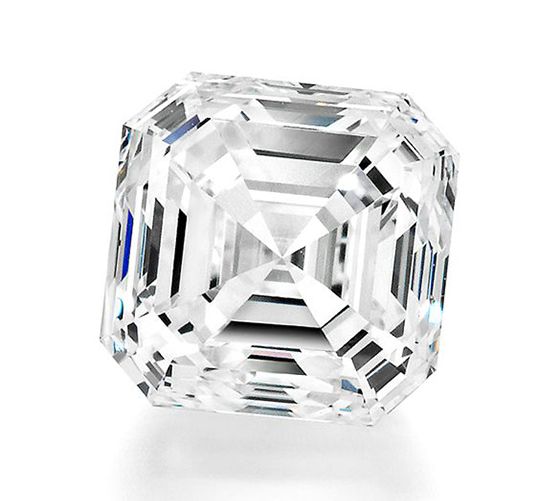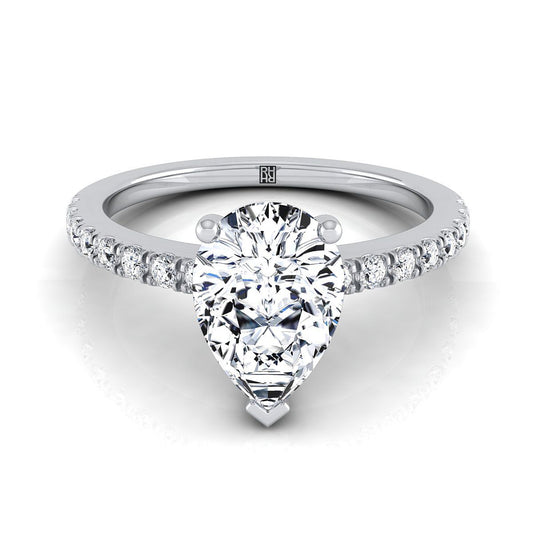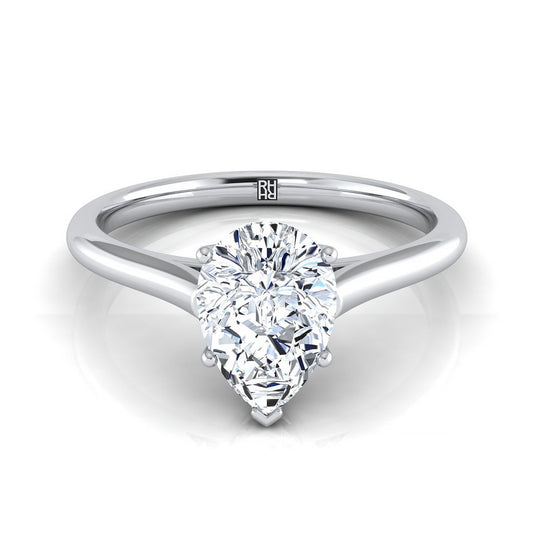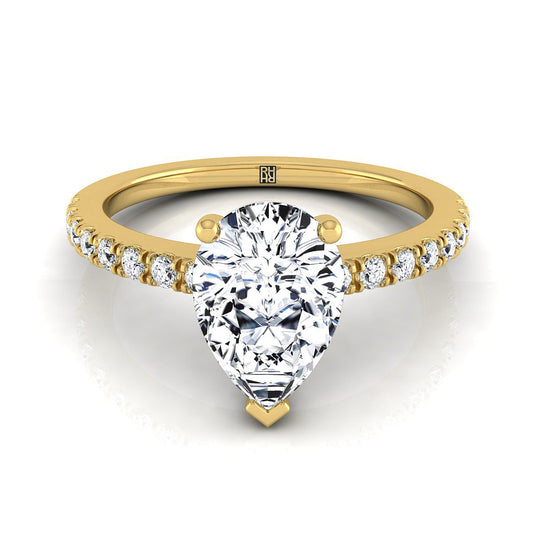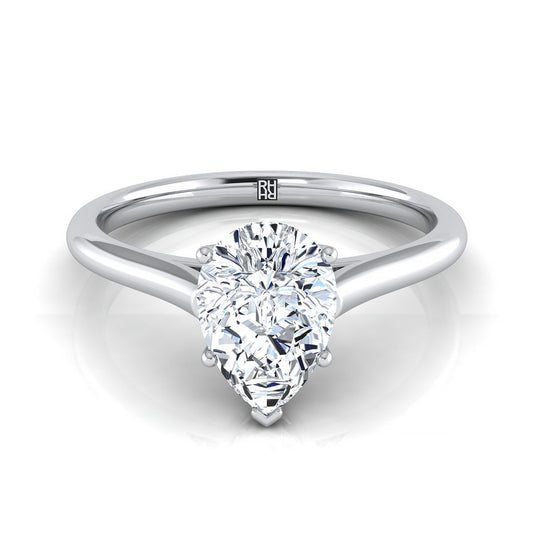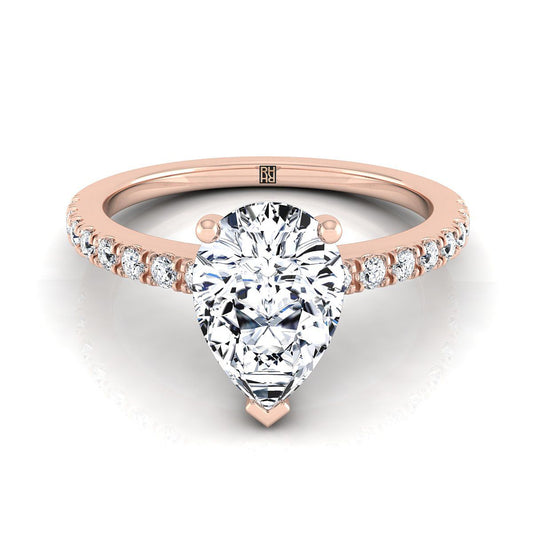PEAR SHAPED DIAMONDS
-
Half round brilliant, half marquise shape, all drama: pear shaped diamonds are the perfect choice for lively and adventurous women who don’t mind being the center of attention. Passionate, compassionate and creative, pear shape diamond lovers don’t follow the crowd, they lead it. This asymmetrical diamond cut is also called a teardrop diamond and beautiful examples will have you crying tears of joy. With their undeniable impact, it’s not surprising that pear shapes are particularly popular among the red carpet crowd.
As Featured In
-
The History of Pear Shaped Diamonds
The story of the pear-shaped diamond begins with the invention of a very special wheel. In 1475, a Flemish cutter named Lodewyk invented the scaif: a diamond polishing wheel coated in oil and diamond dust with an arm above it to hold the diamond. Using this special cutting wheel he could facet diamonds with more precision than ever before. He soon used his wheel to cut a pendeloque-cut diamond, a faceted pear shape that was the first true teardrop shape brilliant diamond.
In 1908, Belgian cutter Joseph Asscher cut the world’s largest rough diamond, the 3,106.75-carat Cullinan. The largest of the 105 polished diamonds cut from the rough is the 503.20-carat Cullinan I, the Great Star of Africa, the most valuable pear-shaped diamond in the world.
-
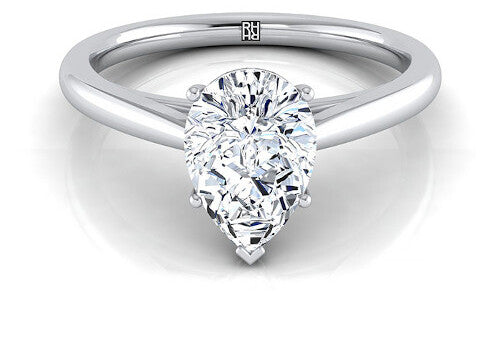
-
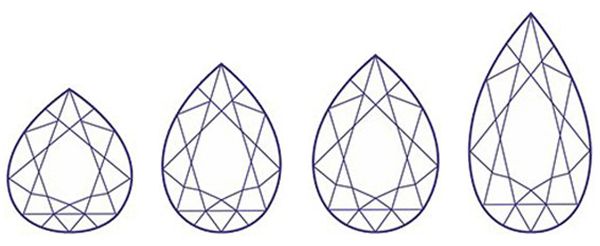
-
Pear Shape Diamond Quality Checklist
- Color H-D
- Table 54%-65%
- Clarity VS2-FL
- Symmetry Very Good-Excellent
- Length to width ratio 1.45 to 1.65
- Polish Very Good-Excellent
- Depth 60%-66%
- Fluorescence Medium-None
-
How to Buy Pear Shaped Diamonds
Ready to pick a pear? Here’s what you need to know about shopping for pear shape diamonds. Because pear diamonds are less common than round brilliants, many retailers won’t have any in stock. You are much better off buying fancy shapes like this online because you’ll have a much better selection in your target color, clarity and carat weight so you can assess the shape and cut quality and pick a really beautiful diamond that’s a good value too.
It’s important to rely only on diamond grading reports from GIA or AGS, the world’s most respected diamond grading laboratories. You can’t rely on the grades from other labs to be equivalent.
When you are shopping for pear shaped diamonds, the first factor that you’ll want to consider is the length to width ratio: a comparison of how round or elongated the pear shape is. A ratio of 1 would be round and a ratio of 2.0 would be longer and skinnier. Which you like best is a matter of personal taste but most people prefer something in the middle. Look for a smooth outline, without any egg-like bulges that conceal extra weight.
-
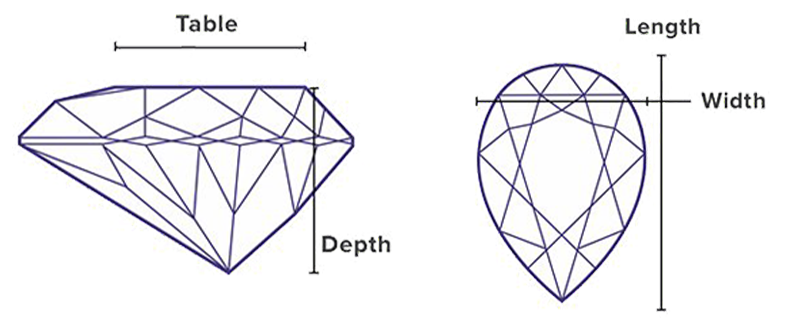
-
The largest diamond in the British Crown Jewels and the largest colorless diamond in the world, the Great Star of Africa is set in the head of the Sovereign’s Sceptre with Cross.
Perhaps an even more famous pear-shape diamond is the 69.42-carat Taylor-Burton diamond. Originally a ring, it was too big to wear on a finger even for Elizabeth Taylor. She reset it into a necklace, which she wore to the 42nd Academy Awards
-

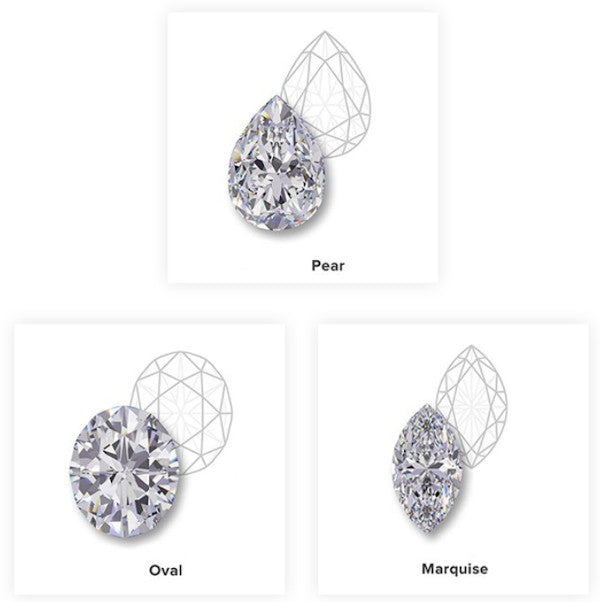
Pear Shaped vs Oval Cut vsMarquise Shape Diamonds
The two diamond cuts that are most similar to a pear shape are the oval cut and the marquise shape.
The oval shape diamond has a similar elongated silhouette and shallower depth means it also looks larger on your finger than a round brilliant the same weight. It is much more symmetrical than the pear shape: it’s less dramatic and more quietly refined.
A marquise cut is another option for those who love the pear shape. It has a similar finger-lengthening silhouette and large face-up appearance. It often is even less per carat because it isn’t quite as fashionable as the pear shape right now.
Why We Love Pear Shaped Diamonds
Like a sparkling drop of sunshine, the pear shape diamond catches the light in a mesmerizing way. Pear shape diamonds are perfect for drop earrings and elegant in necklaces. But lately pear-shaped engagement rings are stealing the spotlight.
In addition to their magical finger-lengthening superpowers, pear-shaped diamonds are surprisingly versatile set in almost any engagement ring style, from elaborate vintage settings to sleek bezel-set styles. Pear-shaped halo engagement rings are particularly popular.
Diamond Size Chart
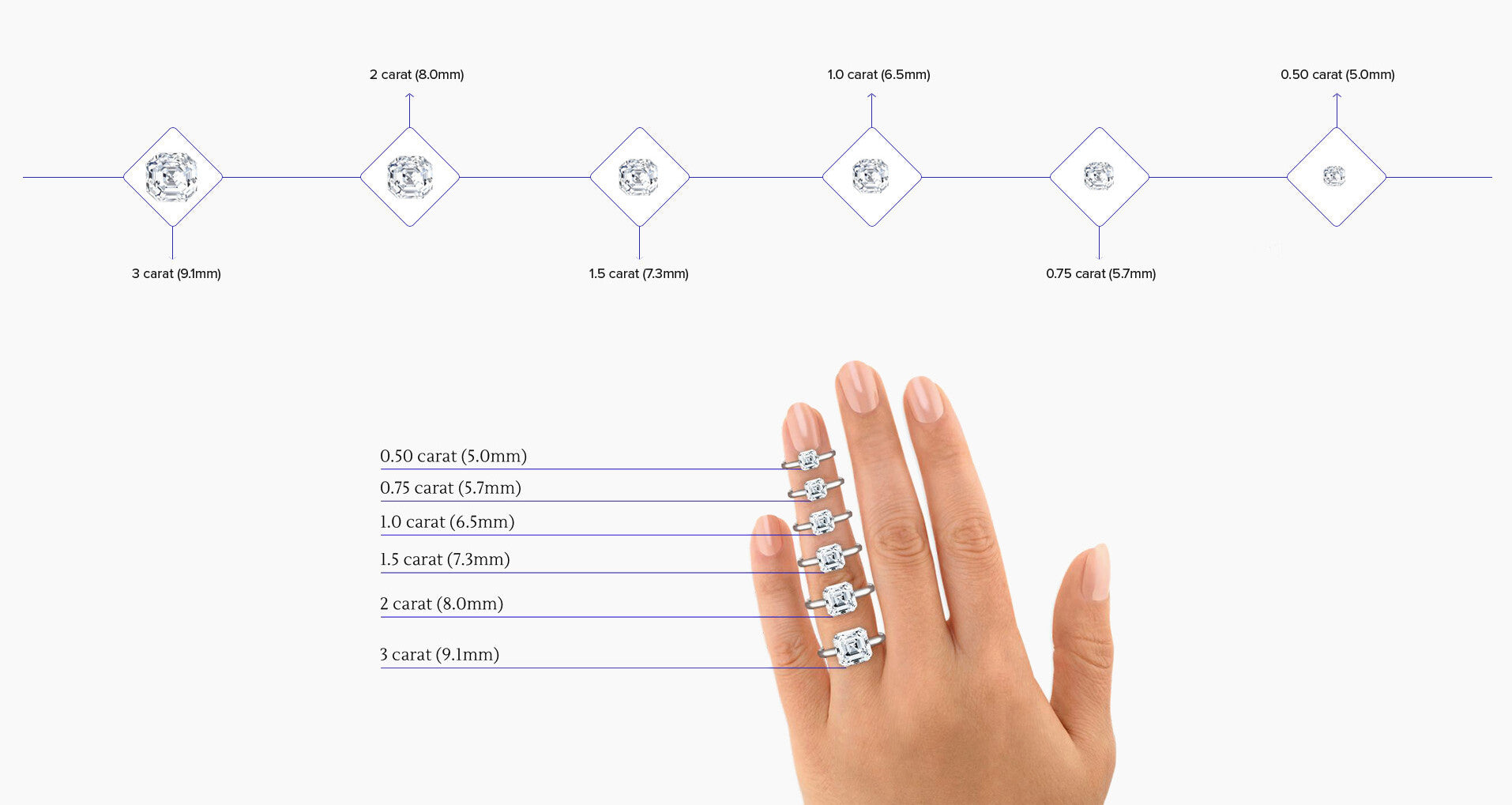
-
Best Pear Shape Diamond Engagement Ring Styles
Our customer’s favorite setting for an Asscher cut engagement ring is a refined Asscher cut solitaire with Our customers’ favorite setting for pear engagement rings is an elegant pear shape diamond solitaire with a diamond band. (Remember to look for a V-shaped prong to protect the point.) If you prefer a classic look, a pear halo engagement ring has extra diamonds and extra sparkle. Because the pear is so distinctive, it also is perfect set a simple solitaire engagement ring. The most popular three stone pear engagement rings have tapered baguettes on the sides. No matter which way you set your pear shaped diamond, unless it is surrounded by a halo, be sure to protect the point with a v-shaped prong.a diamond band. For something a bit more intricate, an Asscher cut halo engagement ring has extra detail (and extra diamonds.). Because this cut is sleek and minimal, many brides also choose a simple solitaire: a bezel-set Asscher cut engagement ring is particularly sleek. Three stone styles are also popular, especially an Asscher cut engagement ring with tapered baguettes on each side.
-
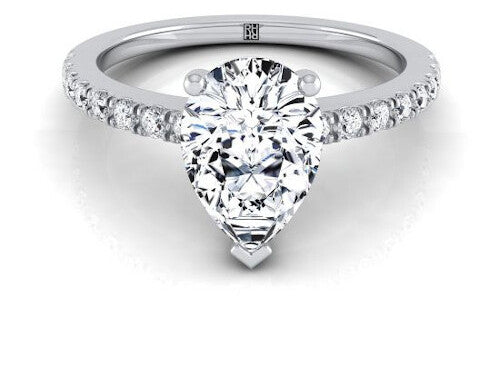
What ROSI Recommends
Balancing quality factors with length to width radios and cut quality can be challenging. That’s why we created ROSI, an artificial intelligence personal shopping tool powered by IBM’s Watson: to sort through all the pear shaped diamonds available on the market to find the best balance of quality and value for your budget. See the best pear shaped diamond for your budget.
ROSI generally recommends a color of H for a pear shaped diamond: J and lower colors will start to show noticeable color in the point of the pear. Clarity should be at least VS2.
-
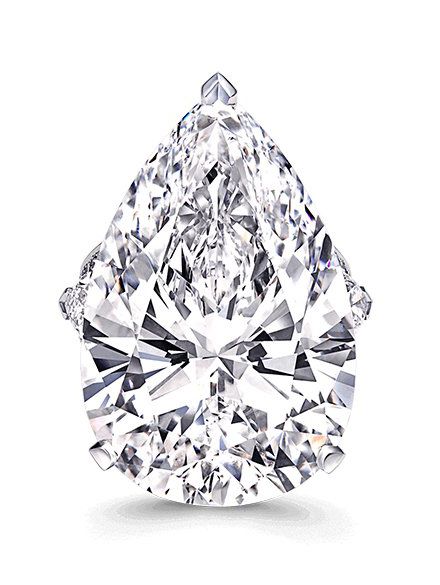
-
But there’s one thing we love most about pear-cut diamonds: they look larger than almost any other diamond shape.
-
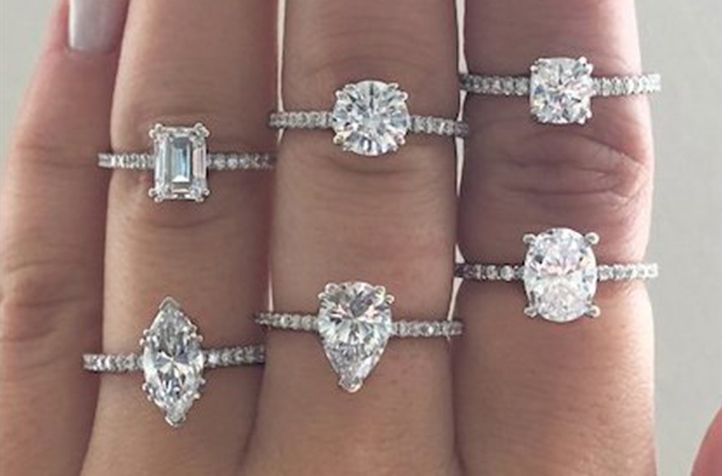
-
Just look at a comparison of rings set with 1.25-carat diamonds in six different shapes.See how big the pear shaped diamond looks in comparison to the round brilliant above it? It’s as if your diamond magically grew 20 percent in size!And there’s one more thing we love about pear shaped diamonds. They are about 20 percent cheaper than round brilliant diamonds of the same size and quality. So pear-shaped diamonds look larger than round brilliant diamonds and they cost less.
-
Many pear shaped diamonds will have a darker area in the middle where the facets don't reflect as well.
This optical effect is called the “bow-tie” effect because the dark area looks like two triangles corner to corner. This can be really distracting and you definitely want to avoid a prominent bow tie. Look for a pear shape that is brilliant even in the center area to make sure your pear-shaped diamond is beautiful in different lighting conditions.
-
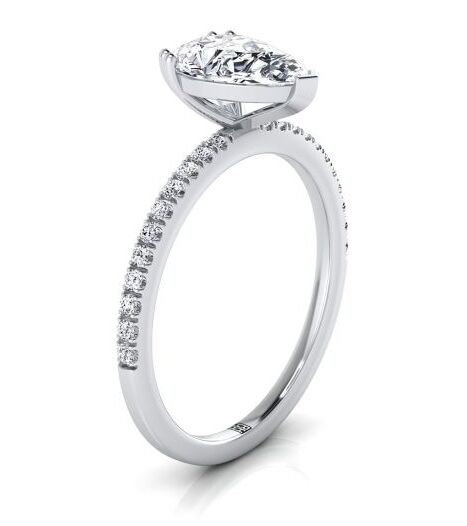
-
Unlike round brilliants, GIA does not offer cut grades for Asscher cuts. The grades you see on the report are for polish and symmetry, not for proportions. Still the grades for polish and symmetry can give you an indication of how the quality of the cutting. AGS does issue cut grades for Asscher cuts.
Make sure you buy your loose Asscher cut diamond from a company that demonstrates a commitment to responsible sourcing. Supporting the Kimberley Process is a great start but the best suppliers go beyond that, sourcing diamonds directly from sightholders and mines.
-
